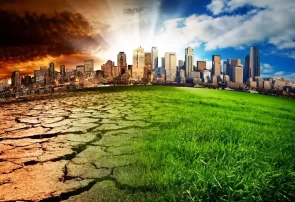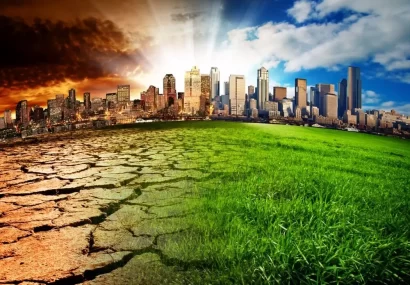TEHRAN (Iran News) –Climate change, land subsidence, deforestation, and water scarcity are among the major environmental challenges in the country.
As per the Seventh National Development Plan (2023-2027), pollution control and environmental protection programs should be integrated with development projects.
According to the Constitution,environmental protection is considered a public duty.
Increasing environmental challenges have recently reached a crisis point.
Soil erosion, drought, dust, waste management, and air pollution, have not only been causing social, political and security problems inside the country, but also threatening future of Iran’s relations with its neighbors.
Climate change
Due to its geographical, economic and climatic characteristics, Iran is one of the most vulnerable countries against climate change.
According to 2019 statistics, Iran is the first country in West Asia and the eighth country in the world in terms of greenhouse gas emissions, especially carbon dioxide.
This situation is related to the lack of modernization and low industrial productivity and the non-optimal production and consumption of hydrocarbon products and improper development of clean and renewable energies in the country.
A large area of the country is prone to floods. The indiscriminate expansion of cities and the destruction of forests have exacerbated the situation, and the warming of the earth and the change in rainfall patterns have led to droughts and fires in forests.
Environmental instability
Environmental instability is particularly important in various risks and accidents such as droughts, dust storms, floods and earthquakes.
Affected by the destruction of the environment and climate change, people in Iran and West Asia may suffer from new diseases, and some animals may not survive because they cannot adapt to the new environment to meet their living needs, including drinking water.
Global warming
The average air temperature has increased by about two degrees in different regions of Iran from the calendar year 1300 to the year 1402 (from March 1921 to March 2023).
All the summers of recent years were unusually hot and dry compared to the past 20 years.
Very high temperatures and low humidity in the months of August and September were more than the long-term drought of the region.
If West Asia becomes drier in the long term due to climate change, dust storms will become more intense.
Greenhouse gases
In the Iranian year 1394 (March 2015-March 2016), Iran was the eighth producer of greenhouse gases in the world.
With the escalation of tensions with the United States and the withdrawal of the United States from the JCPOA in 2018, Iran has clearly announced that it will defer any climate action to the lifting of sanctions and the cooperation and assistance of the international community.
The government has been forced to use domestic oil and fuel oil to leave more gas for export. This issue has caused a significant increase in the country’s greenhouse gas emissions.
Destruction of forests
Over the last six decades, millions of hectares of the country’s forests have been destroyed. The area of forests decreased from 19 million hectares in the calendar year 1369 (March 1990-March 1991) to 10.7 million hectares in the year 1394 (March 2015-March 2016).
If we continue with this trend, there will be no trace of Iran’s forests by the next 75 years. Construction, illegal cutting of trees, overgrazing of pastures and forest fires caused by climate change and carelessness of some people are important factors of deforestation.
Soil erosion
Soil is the most important element in providing food security. According to a report approved by the Food and Agriculture Organization, Iran loses 2 billion tons of soil annually, which means that an average of 7 to 10 tons per hectare of Iranian soil is eroded.
Half of this amount is due to water erosion and the other half is due to wind erosion. Considering that the total soil erosion in the world is 24 billion tons, actually one twelfth of the total soil erosion in the world occurs in Iran.
Considering that Iran occupies one percent of the world’s dry land, the rate of erosion compared to its surface is 8 times the global average, one of the highest figures in the world.
Depletion of underground water tables
In the last two decades, about 100 billion cubic meters of surface and underground water resources have been taken on average annually for various purposes. This issue has had a lot of negative impacts.
Reduction of water level in wells, increase of salt water penetration into underground aquifers, and increase of land subsidence are some of the worrisome consequences of the situation.
Water stress
Water stress is caused by unprincipled exploitation of water resources, especially underground water resources in the agricultural sector.
Very low productivity, losses of agricultural products and the lack of suitable prices for water and energy is a big challenge in all sectors, especially in agriculture.
Climate change, drought, inappropriate water transfer projects and non-observance of the principles and basics of land use in industrial activities have caused the emptying of underground water tables, drying up of rivers and wetlands, land subsidence, and the release of fine dust.
Land subsidence
It is estimated that about 66 percent of the country’s plains (about 12 million hectares) are subject to subsidence, which mainly occurs due to the extraction of underground water tables.
The average volume of natural renewable water resources is 110 billion cubic meters, and the amount of exploitable renewable water resources is estimated at about 70 billion cubic meters.
According to the Ministry of Energy, the amount of renewable water in the country has decreased from 140 billion cubic meters to 105 billion cubic meters from 2013 to 2018.
In the past years, 74 billion cubic meters more than the capacity have been removed from underground water tables and the trend is going on.
Loss of wildlife species
The environment is an ecosystem. If one component is removed, all the cycles that depend on it will be destroyed. National plans for the protection of species started more than 50 years ago in Iran and today nearly 10 percent of the country’s land area is protected. About 100 species of vertebrates are vulnerable or endangered.
Air pollution
In recent years, the number of days that Tehran and big cities have enjoyed clean and healthy air quality can be counted on the fingers of one hand.
The drying up of wetlands, the production of dust and industrial activities has been associated with the increase of particles and dangerous gases in the air, as well as the increase of pollutants in the air, especially in cities.
The industrial pollution of cities, which is mostly caused by the hydrocarbon fuels of the cars, makes it difficult to breathe, especially in the second half of the year due to the inversion of the air.
- source : Tehrantimes






























